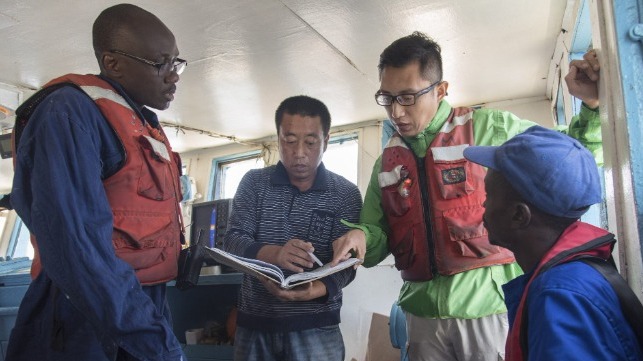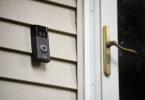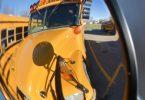[ad_1]
Protection by fishing observers, at all times restricted, has been nearly non-existent throughout the coronavirus pandemic. Is digital monitoring the best way ahead?

[By Shi Yi]
A 360-degree digicam observes the deck of a ship off New Zealand. Because the fishers carry up their traces, they discover they’ve ensnared a black petrel. The fowl, with its black feathers and pale-yellow hooked beak, breeds solely in New Zealand and is one among about 5,000 adults worldwide. No one on board observed it diving into the water and getting trapped. The boat’s primary fishing line is tens of kilometers lengthy, with thinner subsidiary traces branching off. From these traces dangle barbed hooks.
The New Zealand authorities and conservation our bodies have been working to cut back uncommon fowl bycatch. The fishers hurry to take away the petrel and return it to the ocean earlier than the onboard observers see what’s occurred. However the digicam sees and uploads all.
The authorities hope to make use of digital monitoring like this to learn the way many black petrels die yearly after being caught in fishing gear, and if the fishing vessels are taking measures to forestall it.
Fortunately, this was only a drill, the fowl a dummy purchased on board by the crew. They’re working with the federal government, serving to to coach software program to determine black petrel bycatch.
The fishing business wants distant oversight
Chris Rodley, head of SnapIt, the corporate growing the system, described that scene in dialog with China Dialogue. He defined workout routines prefer it are important to make up for the shortage of a video archive to tell the software program. As issues stand, the authorities want to observe hours of video manually. Machine filtering can enormously scale back the time it takes to carry out the duty.
Digital monitoring might assist hold tabs on catches, too. Vessel monitoring techniques at the moment in widespread use inform regulators the place a vessel is and the way it’s working, however can’t assess catches. Fishing logs can fill in that hole although cross-verification is tough. Precise catches could be checked towards logs when the vessel arrives in port, however fish could also be dumped at sea, or illegally transshipped to a different vessel.
By combining location knowledge with picture recognition and different applied sciences, digital monitoring would enable authorities to observe the boat because it operates and spot unlawful fishing or the dumping of catch. As synthetic intelligence improves so will the chances. Those that analysis fishing sustainability have excessive hopes.
Digital monitoring can’t be bribed, threatened, get sick, and it doesn’t have to sleep. That’s very, very highly effective.
Fishing observers act as emissaries of the authorities and could be very efficient at tackling fisheries abuses. However there are solely round 2,500 of them worldwide, in comparison with a whole bunch of 1000’s of fishing vessels. It’s lonely work, typically involving intimidation and even loss of life. A Taiwanese media outlet, The Reporter, discovered that 14 observers went lacking or had been harmed whereas working between 2010 and 2020.
During the last yr, the pandemic has pressured authorities and fishery organizations to chop again on commentary. For instance, the Western and Central Pacific Fisheries Fee based mostly in Micronesia despatched observers again to their residence ports for greater than half of final yr. An vital methodology of keeping track of fishing, each in nationwide waters and on the excessive seas, was misplaced.
Mark Zimring, large-scale fisheries director for The Nature Conservancy, mentioned that “digital monitoring, both used independently or as a complement to observers, can’t be bribed, threatened, get sick, and it doesn’t have to sleep. That’s very, very highly effective.”
Getting forward of the sport
Digital monitoring isn’t fully new. Trials had been run on sablefish and Dungeness crab vessels in Canada 30 years in the past. Lately, some Pacific Island nations have been taking the lead. In 2018, the president of Micronesia introduced that by 2023 his nation would have full in-person or digital monitoring of all tuna fishing vessels in its waters. He referred to as on different small island nations to do likewise, in order to make the business extra clear. Micronesia’s waters are identified for his or her tuna shares. Yearly fishing licenses are granted to about 100 vessels from world wide, however digital monitoring continues to be solely carried out on a couple of.
“The withdrawal of observers because of the pandemic highlights a necessity for various technique of fishery monitoring; digital monitoring is an acceptable possibility in such instances,” mentioned Eugene Pangelinan, deputy director at Micronesia’s Nationwide Oceanic Useful resource Administration Authority. He informed China Dialogue that political will is vital if digital monitoring is to be expanded.
However even in high-value fisheries, using onboard observers could be prohibitively costly. Within the US, prices might attain $700 a day for a single observer. Digital monitoring is less expensive.
In 2019, fishers in Maine labored with researchers to check digital monitoring. Native scallop populations had been as soon as nearly destroyed by overfishing, however the shellfish has returned because of conservation measures and warming waters. Regulators, researchers and fishers all know they want higher knowledge to handle fishing and make sure the harm doesn’t reoccur. The fishers see supporting these trials as in their very own pursuits. Mary Hudson, director of fisheries applications with the Maine Coast Fishermen’s Affiliation, was concerned within the trial. In a podcast, she mentioned that scallop vessels in Maine are usually not at the moment required to have observers on board, however the fishers know it is going to occur eventually. “So,” she mentioned, “they needed to get forward of the sport, begin testing out utilizing cameras for monitoring in order that when the time got here, they wouldn’t should have observers on their small boats.”
The implementation problem
The massive-scale roll-out of digital monitoring has been sluggish. That is regarding given the dimensions of the issue. In 2018, the worldwide recorded fishing catch reached 85 million tonnes. A lot fishing exercise goes on unmonitored. Analysis from 2016 discovered that as a lot as one-third of the worldwide fishing catch could also be unreported.
Zimring informed China Dialogue that solely 2,000 fishing vessels globally have the expertise put in. The Nature Conservancy is working so that every one massive fishing vessels have it put in within the subsequent 5 to 10 years. There are round 100,000 such ships, some so long as 130 meters with a catch capability of over 2,000 tonnes.
“The challenges [with expansion of electronic monitoring] are political, not technological,” Zimring mentioned. He informed China Dialogue that stakeholders all have their very own pursuits. For the boat house owners, there are problems with crew privateness and knowledge safety. And in some nations, the political will is missing.
Numerous Chinese language fishing vessels are at work in China and elsewhere. Official knowledge reveals the nation had over 140,000 fishing vessels of all sizes as of the tip of 2019, with 2,701 of those being registered for distant-water fishing. Though monitoring and transparency are on the rise, there may be a lot room for enchancment. A Chinese language skilled who required to be nameless, factors out that the authorities are sometimes unable to substantiate that the fishing logs submitted by vessels are correct, but “no matter goes within the logs leads to the statistics.”
She says for China, just a few distant-water vessels, and even fewer coastal boats, are trialling digital monitoring. Many vessels have put in cameras of their very own accord, however just for the captains and house owners to make use of to handle the crew and guarantee security. The photographs are hardly ever saved and are usually not handed on to the authorities.
One other Chinese language researcher, who most popular to not be named, mentioned the AI which digital monitoring depends on must be improved. For instance, accuracy of research throughout completely different climate situations has to get higher. However he emphasised that the larger problem is defining every occasion’s rights. As an example, how ought to disputes over data gathered by digital monitoring be settled? “There’s an extended approach to go but,” he mentioned.
Regardless of the challenges, there are not any higher alternate options in sight. Zimring harassed that within the present circumstances “we’re not selecting between observer and digital monitoring. We’re selecting between no monitoring and digital monitoring.”
Shi Yi is a senior researcher at China Dialogue.
This text seems courtesy of China Dialogue Ocean and could also be present in its unique kind here.
The opinions expressed herein are the writer’s and never essentially these of The Maritime Government.
[ad_2]
Source link







